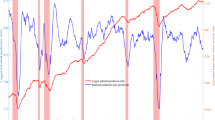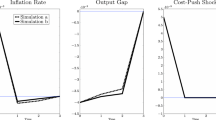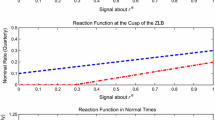Abstract
In this paper we develop a framework to analyze the optimal policy of an inflation-targeting monetary authority that is not fully confident about its model and the degree of mistrust changes over time as the structure of the economy changes. These changes can include structural breaks as well as price, output or real exchange shocks. We use robust control to denote the degree of uncertainty aversion of the policy maker and a Markov chain to capture the time-varying nature of the uncertainty aversion. We find that in general a more aggressive interest rate policy is the optimal response to: (i) more uncertainty aversion and (ii) higher likelihood that the uncertainty aversion may appear in the future. Moreover, we find that the policy maker’s welfare decreases when there is an increase in uncertainty aversion. However, the transition probabilities in the Markov-chain have ambiguous effects on the policy maker expected losses.
Similar content being viewed by others
References
Amano R. (2006) Inflation persistence and monetary policy: A simple result. Economics Letters 94: 26–31
Angeloni I., Coenen G., Smets F.R. (2003) Persistence, the transmission mechanism and robust monetary policy. Scottish Journal of Political Economy 50(5): 527–549
Ball L. (1999) Policy rules for open economies. In: Taylor J. (eds) Monetary policy rules. Chicago University Press, Chicago, pp 127–144
Banco de México. (2005). Summary of the quarterly inflation report, October–December 2004. Distrito Federal, Mexico.
Blake, A. P., & Zampolli, F. (2004). Time consistent policy in markov switching models. England: Monetary Assessment and Strategy Division, Bank of England
Brainard W. (1967) Uncertainty and the effectiveness of policy. American Economic Review 58: 411–425
Coenen G. (2004) Inflation persistence and robust monetary policy design. Journal of Economic Dynamics and Control 31(1): 111–140
Gilboa I., Schmeidler D. (1989) Maximum expected utility with non-unique prior. Journal of Mathematical Economics 18(14): 141–153
Gonzalez F., Rodriguez A. (2004) Robust control: A note on the response of the control to changes in the ‘free’ parameter conditional on the character of nature. Computational Economics 24: 223–238
Hansen L., Sargent T. (2007) Robustness. Princeton University Press, Princeton
Kendrick D. (2002) Stochastic control for economic models. Mc Graw Hill, New York
Liu J., Pan J., Wang T. (2002) An equilibrium model of rare event premia. The Review of Financial Studies 18(1): 131–164
Orphanides A., Wieland V. (2000) Inflation zone targeting. European Economic Review 44(7): 1351–1387
Sargent T. (1999) Comment. In: Taylor J. (eds) Monetary policy rules. Chicago University Press, Chicago, pp 144–154
Söderström U. (2002) Monetary policy with uncertain parameters. Scandinavian Journal of Economics 104(1): 125–145
Walsh, C. (2004a). Implications of a changing economic structure for the strategy of monetary policy. Working Paper, Santa Cruz Center for International Economics. Paper 03-18
Walsh C. (2004b) Robustly optimal interest rules and robust control: An equivalence result. Journal of Money, Credit, and Banking 36(6): 1105–1113
Walsh C. (2005a) Endogenous objectives and the evaluation of targeting rules for monetary policy. Journal of Monetary Economics 52: 889–911
Walsh, C. (2005b). Parameter misspecification and robust monetary policy rules. European Central Bank, Working Paper No. 477
Zampolli F. (2006) Optimal monetary policy in a regime-switching economy: The response to abrupt shifts in exchange rate dynamics. Journal of Economic Dynamics and Control 30: 1527–1567
Author information
Authors and Affiliations
Corresponding author
Additional information
The opinions in this paper correspond to the authors and do not necessarily reflect the point of view of Banamex or Citigroup.
Rights and permissions
About this article
Cite this article
Gonzalez, F., Rodriguez, A. Monetary Policy Under Time-Varying Uncertainty Aversion. Comput Econ 41, 125–150 (2013). https://doi.org/10.1007/s10614-011-9303-x
Accepted:
Published:
Issue Date:
DOI: https://doi.org/10.1007/s10614-011-9303-x




